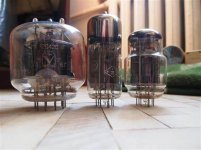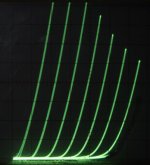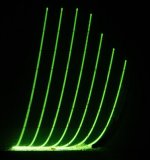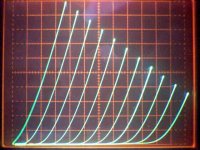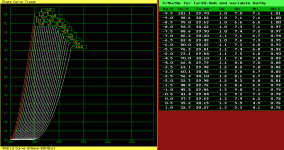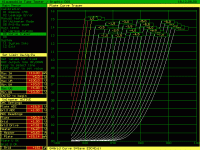Soviets also made 12c42c...which are unlikely to ever be found...but what a beast!
Attachments
Last edited:
Yes v4lve, I have been satisfied with 6c19 in a differential output stage and Morgan Jones used a 6528 in a published SE design, achieving 6.8 watts at 3.2 % THD. However, I think using these regulator valves is going to be a pretty minority activity. The Americans seem to have huge stocks of the TV beam power valves of many different types. I don't know about continental Europe but that is not the case in the UK; the only one I ever see in any quantity and at a reasonable price is EL36 (black and white TV). It's easier and cheaper to get Russian ones (6P36S is a fantastic sleeper, nice in triode even without feedback).
Wow acg, a beast indeed! I know that 6s33 is two paralleled 6s41; is the 12s42 four in parallel?
What is the valve in the middle?
What is the valve in the middle?
6C41 edit im not so sure.
Jogis did a great write up on the russian 6C triodes Leistungs-Trioden made in Russia
Jogis did a great write up on the russian 6C triodes Leistungs-Trioden made in Russia
There is a whole thread on this from August 2019: "power triodes indirect vs direct heating".
Most of the science is considered.
Of course, there are scarcely any indirectly heated power triodes.
Unfortunately, that thread was inconclusive because no comparisons can be fairly done between DHT and triode-connected sweep tubes.
However, this DHT-IDHT pair of 6B4G and 6A5G provides an opportunity to answer the question of whether DHT are inherently superior.
I can volunteer to procure a sample of 6A5G. Smoking amp has the means to trace its curves. Is there anyone who has a 6B4G SET amplifier to compare sound quality?
Piano3, I believe that is the 6C47C.
The 12c42c is I believe 3 x 6c33c sections connected internally in parallel. I have never seen one...that is an internet photo. Rp is extremely low, something like 75ohm. Would love to find some to play with.
The 12c42c is I believe 3 x 6c33c sections connected internally in parallel. I have never seen one...that is an internet photo. Rp is extremely low, something like 75ohm. Would love to find some to play with.
Found some info on the 6C47C: either a pass tube or a pulse tube
Looks to be unobtanium.
6S47S | Tubes Information
Looks to be unobtanium.
6S47S | Tubes Information
Russians made a number sort of “similar” regulators tubes: the low gain triodes - 6C19P, 6C41C, 6C47C, 6C33C, 6C18C, 12C42C. The 6C41C, 6C33C and the 12C42C are essentially the very same tubes but with different number of anodes, and consequentially with different dissipation power
However, in several places I heard different ratings of the first 6c41c, which should be in fact a "real" ordinary triode and by the logic of things should sound the best, from recommendations to ratings that can not be compared with the bigger brother 6c33c ...
... But, then again, they don't give any curves for the 6A5G, one does wonder. One for a curve tracer to decide...
Thomas Mayer (VinylSavor) had a 6AG5 on his curve tracer:
VinylSavor: Tube of the Month : The 6A5
unfortunately he does not tell us the scales ...
Probably the same scales at least, look similar
2A3 then 6A5 curve pics from VinylSavor
both of them have some limited roll-over, but the 6A5 looks to have a little more
3rd pic 1E7G, a small DHP in triode, with low roll-over
It would be interesting to see an 8042 DHP trace next to a 6146 trace. I've got an 8042 on the way. And a 6146 on the shelf.
2A3 then 6A5 curve pics from VinylSavor
both of them have some limited roll-over, but the 6A5 looks to have a little more
3rd pic 1E7G, a small DHP in triode, with low roll-over
It would be interesting to see an 8042 DHP trace next to a 6146 trace. I've got an 8042 on the way. And a 6146 on the shelf.
Attachments
Last edited:
6P 43P triode curves from Klaus: And the low voltage curves:
Tube Tester Files - EL82, EL84, EL86 Soviet Clones
Tube Tester Files - EL82, EL84, EL86 Soviet Clones
Attachments
I looked at data sheet curves of common DH and IDH triodes. The only one that impressed me with low curve rollover is 01A. Three other DHT renowned for fine sound, 10, 71A, and 45, are, IMO, nothing to write home about, if compared to 27 or 56.
I am not convinced that low rollover explains the sonic signature of DHTs.
I am not convinced that low rollover explains the sonic signature of DHTs.
I looked at data sheet curves of common DH and IDH triodes. The only one that impressed me with low curve rollover is 01A. Three other DHT renowned for fine sound, 10, 71A, and 45, are, IMO, nothing to write home about, if compared to 27 or 56.
I am not convinced that low rollover explains the sonic signature of DHTs.
If we could all begin by agreeing that a sonic signature, whatever that turns out to be, exists *in the curves* (or better, in an interpretation of them) we would have a truly interesting discussion. Maybe to begin, we could specify that IM effects of AC heating on non-unipotential cathodes has been dealt with, and that everything of interest exists in the curves and no magic allowed.
Then the question moves to: what imperfections in the curves matter, and which don't?
YOS,
Chris
An electron tube isn't a telephone. It won't tell you their best working point by the numbers in the datasheets. You have to hear it, have to test it.The curves are very similar, the difference lies in their performance.
Otherwise, its all theory.
And no simulation will replace practice.
You can simulate for ages, If you don't have practice in working with tubes, its all worth nothing.
Obviously there is going to be distortion in any device whose "curves" are not equally spaced straight lines. In the other thread, DF96 made the point that the reason for the superior linearity of 300B, 845, 211 and so on, is their size (all our electrostatics formulae assume infinite parallel planes, infinitely long cylinders etc.), not the fact that they are directly heated. He further reasoned that it should be possible to make indirectly heated triodes more linear as it is possible to more exactly control the shape of the cathode so that the electrodes are self-similar. I wonder if valves have ever been made with the cathode and grid as concentric spheres?
Obviously there is going to be distortion in any device whose "curves" are not equally spaced straight lines. In the other thread, DF96 made the point that the reason for the superior linearity of 300B, 845, 211 and so on, is their size not the fact that they are directly heated.
I don't use any small 9 pin tubes and haven't for years. Not that I'm against them, but I have found that the older and larger tubes just seem to sound better. The older types with octal, loctal, side contact and all the other larger old bases. I know this is a broad generalisation, but I'm just calling it as I hear it.
> In the other thread, DF96 made the point that the reason for the superior linearity of 300B, 845, 211 and so on, is their size (all our electrostatics formulae assume infinite parallel planes, infinitely long cylinders etc.), not the fact that they are directly heated.
I have no doubt that that is true.
The question is whether any implementation of a high-linearity unipotential cathode is a practical solution.
With indirect heating and the big spaces around the cathode needed for linearity, the heating power rapidly becomes very high. this in turn leads to hot grids - grid emission, and mechanical distortion.
I suspect that this is the reason that there are no indirectly-heated analogues of the 845, for example.
I have no doubt that that is true.
The question is whether any implementation of a high-linearity unipotential cathode is a practical solution.
With indirect heating and the big spaces around the cathode needed for linearity, the heating power rapidly becomes very high. this in turn leads to hot grids - grid emission, and mechanical distortion.
I suspect that this is the reason that there are no indirectly-heated analogues of the 845, for example.
And so, as in so many cases, a "straightforward" solution hinted at by physics becomes a massive headache for the engineers!
That could be true but it mustn't.I don't use any small 9 pin tubes and haven't for years. Not that I'm against them, but I have found that the older and larger tubes just seem to sound better. The older types with octal, loctal, side contact and all the other larger old bases. I know this is a broad generalisation, but I'm just calling it as I hear it.
With phono stages, the later tubes had some design advantages. Older tubes often had hum problems, which the later ones get rid of.
I like the sound of the older tubes, but in general its not always that those do sound better. There are noval and others that have qualities, that are not being available with the older ones.
It seems, that your focus for sound is tubes, tubes, tubes.
The truth is, with the appropriate circuit, every tube can shine.
Before I go and buy two 300B tubes for more than 500€, I'll invest this money in the transformers. There are so many cheap tubes that aren't bad because they are cheap, its just that the other famous dozen are overhyped and overprized. A 300B is a special tube, but as I stated, I would choose it only in a cost no object project. Any budget project will perform better with the money invested in the amp and not the tubes.
Literally I'm pretty sure to beat your 300B project with the right speakers and in small living rooms with a PL82 amp. And that tube costs pennys compared to every 300B. And thats the saying of other people and me, not only my saying. They have swapped their 300B legend for such an amp. And for good reasons.
The electron tube itself means nearly nothing for the sound.
Last edited:
- Home
- Amplifiers
- Tubes / Valves
- Why has single ended output become popular
